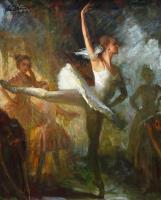
Zhiwei Tu
Zhiwei Tu was born in Northern Guangdong Province, China, in 1951. As a child, he worked his family’s land, herded sheep, and attended the village school. It was there that he became infatuated with painting and drawing. When he was in high school, a professional artist was sent to the village to paint a portrait of Mao Zedong. For seven hours straight, Tu watched the artist work, and afterward, he bought his own paints and painted his own portrait of Mao. When he showed it to the village officials a few days later, they decided to display his piece as it was far more impressive than the commissioned piece.
By 1975 he had earned a BA from the Guangzhou Institute of Fine Arts in Canton and became a teacher of art at the Teaching College of Shiao Gaun, China. The Cultural Revolution in China forced the closing of all graduate programs until 1978 when the movement lost its energy. During the interruption of his studies, Tu traveled extensively throughout China studying Chinese history and culture, and producing hundreds of paintings. Later, these served as great sources of information and inspiration for much of his work. Finally, in 1978, Tu entered a competition for admission to the Guangzhou Institute, won, and entered to earn his master’s degree. Staying there only three years, he moved on the become Professor of Fine Art at the Guangzhou Institute, and while teaching he earned his MFA in 1981.
In 1987, Tu entered Drake University in Des Moines, Iowa, to study both Art and English full-time. During those three years, he drove all over the midwest and east coast to over twenty invitational shows in Minneapolis, Chicago, and Kansas. Ever since then, Tu has had numerous one-man shows all over the United States and throughout the Orient.
Zhiwei Tu is quite humble about his success and talent: “When very young, I used to look at my hands in wonderment and try to understand how beauty could come forth from them. I still have that feeling every time I put a brush to a canvas.” Many artists are terrified by the idea of large paintings - every skill is tested in a large piece: detail, composition, and especially perspective. However, Tu thrives in this place, allowing Chinese history to unfold by way of his mastery of lighting and drama. He has diligently worked at creating some of the most dramatic art to come out of China in the last 50 years.